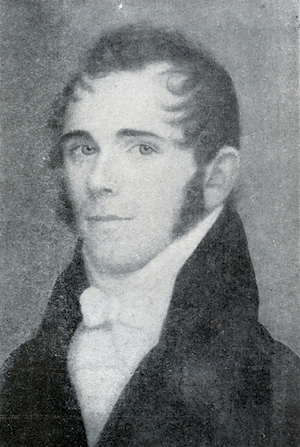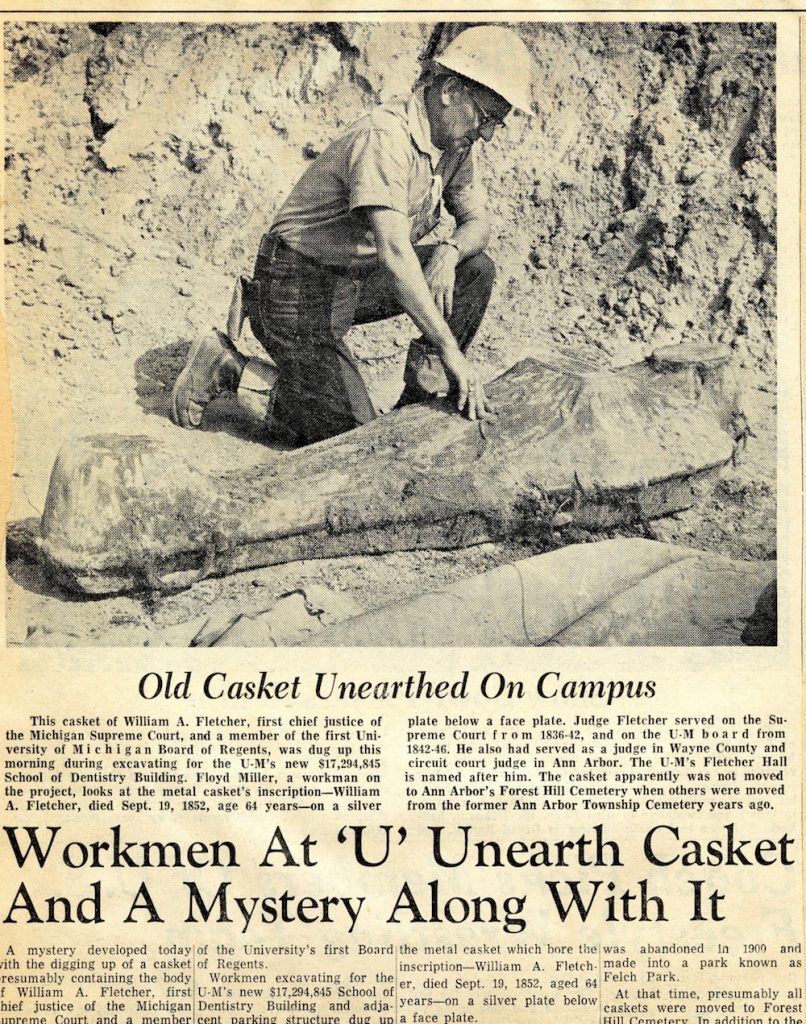What Will We Find This Time?7 min read
Casket found during construction project in 1966 linked dental school to city and state history
This story was originally published in the Fall 2018 Dentalum alumni magazine.

Ann Arbor, Mich., Dec. 1, 2018 — As excavation and construction move forward on the School of Dentistry’s $140 million renovation and addition, it seems unlikely that workers will unearth anything as extraordinary as what was found 52 years ago during the school’s last big building project.
On June 6, 1966, construction workers dug up a 19th century iron casket while they were preparing the foundation for the current building. The discovery forever linked the School of Dentistry with one of the most bizarre tales and compelling mysteries in Ann Arbor history.

A nameplate on the casket said workers had found the body of William Asa Fletcher, the first chief justice of the Michigan Supreme Court, who died in 1852. But that presented a conundrum because an unmarked casket found many decades earlier in the same vicinity was presumed to contain Fletcher’s body and was re-buried in Forest Hill Cemetery in 1918. So if the construction workers at the dental school had found Fletcher, who was in Fletcher’s grave at Forest Hill?
This convoluted story is best told chronologically. Fletcher was born in New Hampshire in 1788. He arrived in Detroit in 1821 and established a law practice while Michigan was still a territory. Gov. Lewis Cass appointed him chief justice of Wayne County and attorney general in 1825. After he was appointed a circuit court judge in 1833, he moved to Ann Arbor because he was required to live within the circuit. He purchased land immediately east of what is today the dental school and it became known as the Fletcher farm.

Fletcher served as chief justice of the Michigan Supreme Court from 1836-42. After Michigan became a state in 1837, he helped rewrite the territorial judicial system into the state code. He was also a University of Michigan regent from 1837-42. After retiring, Fletcher served as a justice of the peace in Ann Arbor until his death in 1852. He was buried in an unmarked grave in the cemetery adjacent to his farm. The cemetery was located in what is now Felch Park in front of U-M’s Power Center for the Performing Arts, just north of the dental school.
When the original cemetery ran out of space, a new cemetery, Forest Hill, was opened in 1857. The old cemetery’s occupants were disinterred and reburied at the new location, but Fletcher’s grave, without a headstone, was not discovered. Over time, his grave was forgotten.
Forty years later, in 1897, Titus Hutzel, Ann Arbor’s superintendent of water works, was supervising installation of water pipes in Felch Park when his work crew unearthed an unmarked iron casket. It was from an era when caskets featured a glass window over the face of the corpse, covered by a removeable metal plate. Those who peered through the window reported that the body was dressed in a suit and appeared to be well-preserved. Hutzel’s mother, Sophie, recalled Fletcher being buried in a similar casket at a well-attended Ann Arbor funeral, so the consensus was that the body must be Fletcher’s. But what should be done with the casket and its supposedly prominent occupant? Fletcher had been married, but the couple had no children. Two nephews of Fletcher were either uninterested or unable to provide for a more respectable burial for the former chief justice. The historical record doesn’t say who decided or why, but the casket was reinterred in the same place and marked this time with some bricks laid flush with the ground.
About 20 years passed before the Michigan Historical Association and State Bar Association took up the cause of providing a more suitable final resting place for Fletcher. In 1916, a committee was appointed to pursue the matter and in 1918 Titus Hutzel was asked to again locate the grave in Felch Park. He found the bricks and dug up the casket for an audience of dignitaries including undertaker R.A. Dolph, U-M Regent Junius Beal, and B.A. Finney of the historical association. After another look through the faceplate window atop the casket, the group again described the body as well-dressed – with a large white neck cloth, frilled shirt front and ceremonial coat. It was also noted that the corpse had perfect teeth.
The casket was moved to Forest Hill and buried in a plot donated by the Cemetery Association. The state historical association paid the burial expenses and another committee was formed to arrange for a suitable headstone. The grave was marked by a boulder for 17 years until, in 1935, a headstone was donated by Joseph L. Arnet of Ann Arbor. A ceremony for the placement of the stone was attended by U-M President Alexander Ruthven, Ann Arbor’s mayor and several university professors. Judge William Potter, chief justice of the Michigan Supreme Court, gave a lengthy address that summarized Fletcher’s life and achievements.
The public officials and historians thought they had finally brought closure to the story about the life — and death — of the first chief justice of the Michigan Supreme Court. But the story changed once more on that day in June 1966 on the north side of the dental school construction site, not far from the old cemetery. This time, there could be little doubt about whose body was in the casket found by construction workers. A shiny silver plate declared the contents: “William A. Fletcher, died Sept. 19, 1852, age 64 years.”
The discovery was rushed into print in the afternoon edition of the Ann Arbor News with a photo and story headlined, “Workmen At ‘U’ Unearth Casket And A Mystery Along With It.” Dr. Frank Comstock, a faculty member on the building’s planning committee, documented the discovery in his construction notebook, describing the casket as “extremely well-preserved and shaped to the contours of the human body.” He drew a simplistic likeness of the casket and mentioned a rumor that the casket was filled with alcohol, quipping, “if so, one could assume he was pickled for 114 years which could be a record.”
Comstock’s notebook indicates Fletcher was reburied at Forest Hill the next day. A photograph from the Fletcher file at U-M’s Bentley Historical Library shows a pastor and seven men in business suits standing around the casket in front of Fletcher’s gravestone. Those paying their respects were identified as a historian, two judges, two U-M officials, a Mason and a former U-M regent. Another photo taken that day shows Fletcher’s casket in the same grave next to the casket that had been buried there in 1918 in the mistaken belief that it was Fletcher.
Thanks to the construction workers building the School of Dentistry in 1966, Fletcher was finally in a properly marked grave, more than a century after he died. As for who is in the other casket buried beside Fletcher, that mystery remains.
